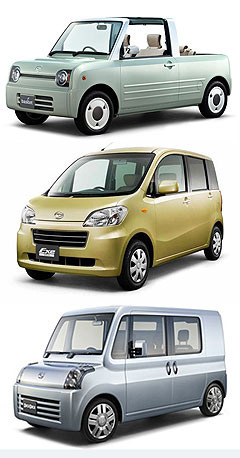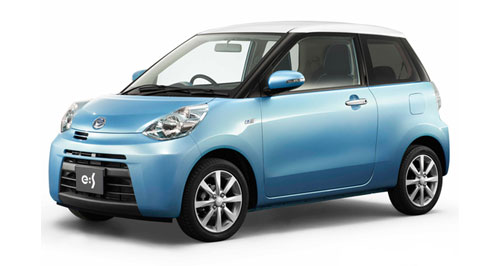Future models - Daihatsu - e:SFirst look: Daihatsu dishes up non-electric eco hero carEco warrior: Daihatsu's e:S uses a conventional petrol engine to achieve thrifty 3.0L/100km fuel economy. Daihatsu bucks EV and hybrid trend but still creates waves with e:S Tokyo concept12 Oct 2009 By TERRY MARTIN DAIHATSU has unveiled an impressive micro-hatch concept dubbed the e:S ahead of its world debut at the Tokyo motor show next week, drawing design inspiration from Mini and dodging the trend toward alternative, electrified powertrains. Although Daihatsu is still beating the environmental drum, and will show the e:S and other concepts under the slogan ‘Innovation for Tomorrow’, the Toyota-owned small-car brand will demonstrate just how economical its models can be using conventional engine technology and lightweight construction. Based on Daihatsu’s light-car platform, the e:S – which draws its name from ‘eco’ (not electric) and ‘smart’ – uses a conventional 660cc petrol engine that is claimed to enable a combined fuel consumption figure of 3L/100km thanks, in large part, to idle-stop technology and an overall weight of 700kg. The latter is achieved via a shorter wheelbase (2175mm) and more compact dimensions than current models such as the Sirion and Cuore/Charade – still with a package that is claimed to accommodate four adult passengers – as well as lightweight mechanical components and interior fittings, including ultra-slim front seats.  Left: Daihatsu Basket Concept, Daihatsu Tanto Exe Concept, Daihatsu Deca Deca Concept. Left: Daihatsu Basket Concept, Daihatsu Tanto Exe Concept, Daihatsu Deca Deca Concept.Other show stars on the Daihatsu stand include the Deca Deca “super box” and the Basket convertible-cum-ute, both of which “propose new possibilities for mini vehicles” from the brand. The Deca Deca features a low, flat floor that allows an expansive and versatile interior in a compact vehicle. Simple access is ensured with pillar-less ‘side-by-side’ doors, while the slim, lightweight seats can be folded and arranged in a host of configurations to turn the cargo area into a work station or, at the other extreme, a van-like compartment that can stow large items. Far removed from Australian-built utilities, and even smaller models such as the Proton Jumbuck, the Basket is an open-top four-seater with a wide rear deck designed, unashamedly, for the “slow pace of life” and for trips “to the family vegetable plot out of the city”. The Basket has a removable hard roof over the driver and front passenger seats, and a removable canvas top over the rear seats. Located behind the rear seats, the deck is designed to transport tools and other hardware. A further point of interest on the Daihatsu stand will be the Tanto Exe and Tanto Exe Custom, two close-to-production compact cars that have a high level of comfort and convenience with luxurious appointments, an expansive interior and “sophisticated” cabin detailing – all with a lighter overall weight than the standard Tanto.  All future models Alfa Romeo Alfa Romeo Abarth Abarth Alpine Alpine Alpina Alpina Audi Audi Aston Martin Aston Martin BMW BMW Bentley Bentley Chery Chery Brabham Brabham Chrysler Chrysler Chevrolet Chevrolet Cupra Cupra Citroen Citroen DS DS Dodge Dodge Fiat Fiat Ferrari Ferrari Foton Foton Ford Ford Great Wall Great Wall FPV FPV Haval Haval GWM GWM Honda Honda Holden Holden Hummer Hummer HSV HSV Infiniti Infiniti Hyundai Hyundai Jaguar Jaguar Isuzu Isuzu Kia Kia Jeep Jeep Land Rover Land Rover Lamborghini Lamborghini Lexus Lexus LDV LDV Mahindra Mahindra Lotus Lotus Mazda Mazda Maserati Maserati Mercedes-AMG Mercedes-AMG McLaren McLaren MG MG Mercedes-Benz Mercedes-Benz Mitsubishi Mitsubishi Mini Mini Opel Opel Nissan Nissan Peugeot Peugeot Pagani Pagani Proton Proton Porsche Porsche Renault Renault Ram Ram Rover Rover Rolls-Royce Rolls-Royce Skoda Skoda Saab Saab SsangYong SsangYong Smart Smart Suzuki Suzuki Subaru Subaru Toyota Toyota Tesla Tesla Volvo VolvoMotor industry news |
Click to shareDaihatsu modelsResearch Daihatsu All future models Alfa Romeo Alfa Romeo Abarth Abarth Alpine Alpine Alpina Alpina Audi Audi Aston Martin Aston Martin BMW BMW Bentley Bentley Chery Chery Brabham Brabham Chrysler Chrysler Chevrolet Chevrolet Cupra Cupra Citroen Citroen DS DS Dodge Dodge Fiat Fiat Ferrari Ferrari Foton Foton Ford Ford Great Wall Great Wall FPV FPV Haval Haval GWM GWM Honda Honda Holden Holden Hummer Hummer HSV HSV Infiniti Infiniti Hyundai Hyundai Jaguar Jaguar Isuzu Isuzu Kia Kia Jeep Jeep Land Rover Land Rover Lamborghini Lamborghini Lexus Lexus LDV LDV Mahindra Mahindra Lotus Lotus Mazda Mazda Maserati Maserati Mercedes-AMG Mercedes-AMG McLaren McLaren MG MG Mercedes-Benz Mercedes-Benz Mitsubishi Mitsubishi Mini Mini Opel Opel Nissan Nissan Peugeot Peugeot Pagani Pagani Proton Proton Porsche Porsche Renault Renault Ram Ram Rover Rover Rolls-Royce Rolls-Royce Skoda Skoda Saab Saab SsangYong SsangYong Smart Smart Suzuki Suzuki Subaru Subaru Toyota Toyota Tesla Tesla Volvo VolvoMotor industry news |














Facebook Twitter Instagram